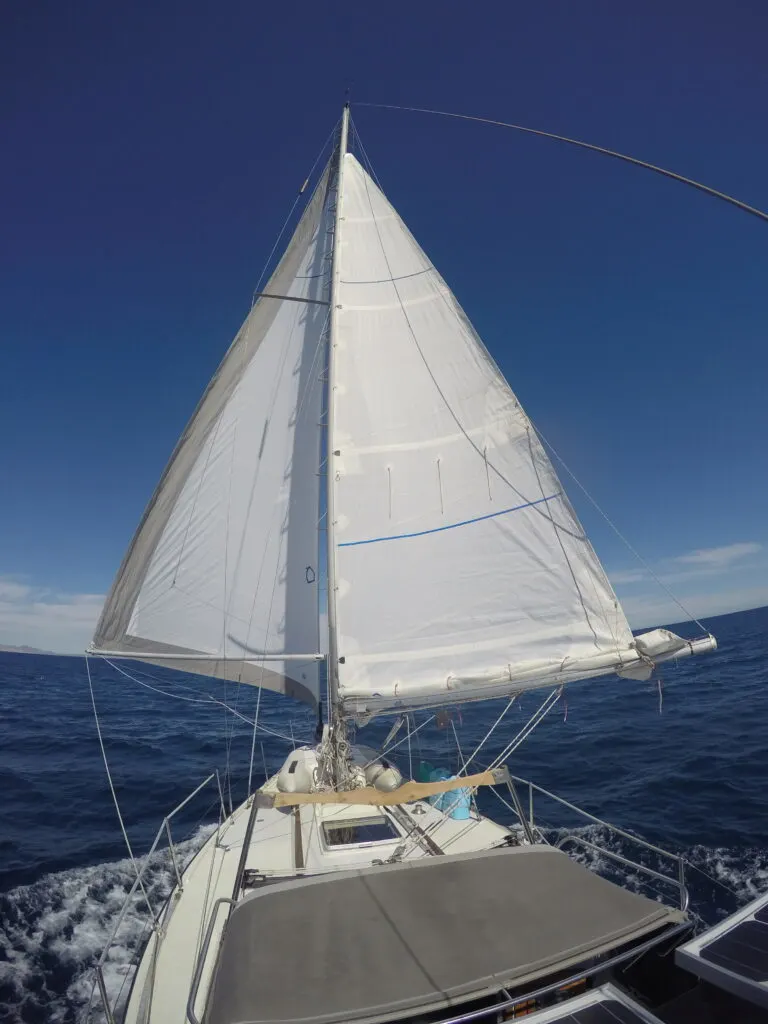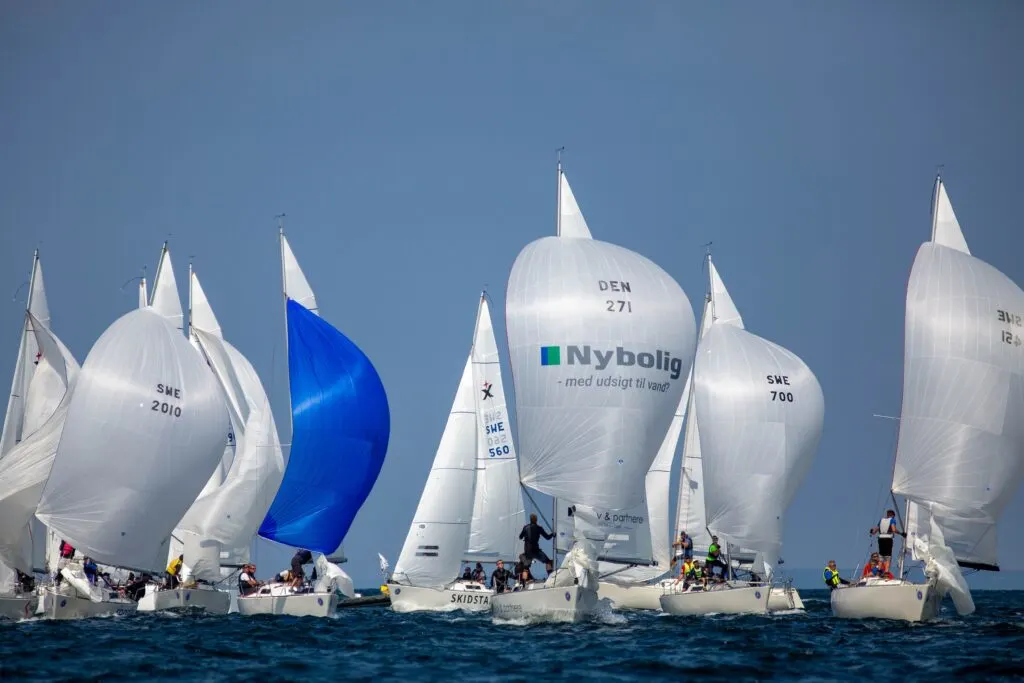Downwind sail terminology can be baffling! If you’re looking to build out your downwind sail inventory for cruising you may find yourself awash with spinnaker codes, headsail overlap percentages, and trying to understand the difference between an asymmetric spinnaker, gennaker, and cruising chute.
But don’t despair, the good news is: it’s not that complicated. All the marketing jargon aside, there are really just three types of downwind sails commonly used by cruisers and I’m going to cover them in this post.
- Headsails
- Asymmetric spinnakers
- Symmetric spinnakers
We’ll also briefly touch on Code sails.
Sure there are more exotic downwind sail options like Parasailers and Blue Water Runners, but the three sails above tend to be the staples in most cruising sail wardrobes.
Also, if you’re looking to buy a downwind sail, be sure to check out our post on buying used sails. Buying second-hand sails is a good way to build out your sail inventory without breaking the bank.

What is the best sail for downwind sailing?
No single sail is going to do everything well. Downwind sails achieve peak efficiency at different apparent wind angles and conditions, which is why performance-oriented boats carry a large inventory of sails. For example, Vendee Globe skippers carry 9 sails (their allowable limit).
As cruisers, we don’t have this luxury. Instead, we make do with fewer, less specialized, sails that can be used over a wide range of wind angles and conditions.
The best sail for downwind sailing is going to depend on your boat, your crew, and what you’re trying to achieve.

Considerations for choosing a downwind sail
Boat and rig
How heavy is your boat and what type of rig does it have? How much space do you have for storing sails?
It’s important to know your boat’s most efficient downwind sailing angle and then choose a sail that performs well at that angle.
Modern, light, flat-bottomed boats often sail faster on a reach, whereas older, heavy-displacement cruisers don’t achieve the same gains from reaching.
You’ll also want to consider your rig and existing sail plans. As we’ll see later in this post, fractional and masthead rig boats will have slightly different downwind sail requirements.

Crew and experience level
Will you have six people onboard or be sailing single-handed? Are your crew newbies or ocean veterans? Are you comfortable handling a pole and working on the foredeck?
Certain downwind sails are more challenging to fly than others. For instance, a symmetrical spinnaker is a lot more effort to launch, fly, and douse, than a genoa on a roller furler.
Often short-handed crews (couples, single-handers, and families with small kids) find that spinnakers are too much work and choose to fly white sails alone. Even the most energetic sailors may find that sleep deprivation on a long passage can sap the fun out of elaborate sail changes.
We, like many cruisers, are very conservative. On our Pacific crossing, I can count the number of times we flew a spinnaker on two hands.
However, now that we have more bluewater miles under our keel, I’m a lot more eager to break out the kite. On our next ocean passage, I can see it playing a bigger role in our downwind repertoire.

What are your sailing goals?
Do you aspire to complete an Atlantic or Pacific crossing? Do you enjoy racing your cruiser? Are you content to motor sail?
The type of sailing will influence what downwind sails you carry.
For instance, if you’re planning on bluewater cruising, your focus might be on durable, heavyweight sails that can handle a squall and stand up to the rigors of an ocean crossing.
Consider how much you want to use your engine. If you’re planning long passages where you don’t have enough fuel to motor, you may want to invest in a light air sail.
Reach out to other sailors with similar boats who are doing the type of sailing you’re interested in and find out what they’re using.
Types of downwind sails

Headsails
Genoas on roller furlers are hard to beat for downwind sailing. They’re robust, easy for a single person to manage on a roller furler, and make for a stable, stress-free downwind sail.
They can become problematic in light air and ocean swell when they tend to flog. The best way to avoid this is to pole out the genoa.

Poled out genoa
Sailing downwind with a poled-out genoa was our go-to setup for much of our 2017 Pacific crossing.
It seems to be a favorite with Atlantic skippers too. Yachting World surveyed 276 ARC skippers to learn about their sail and sail handling systems. “Despite most yachts carrying a spinnaker or offwind sail, over 60 skippers commented that using a poled-out foresail was the most effective downwind option, with twin headsails proving the next most popular.“

Twin headsails
Twin headsails are another great option, and one I would consider for our next ocean passage.
Many roller furlers have a second luff groove so you can fly two headsails at the same time, one to each side. This gives you a large sail area, while still making it easy to reef from the cockpit.
Again, you may need to pole out one sail and sheet the other to the end of a boom that’s been locked off with a boom preventer in order to prevent flogging.
Speaking of which, if you’re planning on doing a lot of downwind sailing I highly recommend using a boom brake or preventer for limiting the risks associated with an accidental gybe.

Headsail types
Headsails are categorized by their Luff Perpendicular percentage (LP%), which describes a headsail’s size/overlap relative to the boat’s J dimension (from where the forestay connects to the bow to the base of the mast). Larger sails, with more overlap, have higher percentages.
Generally speaking, 130-135% headsails are pretty common sizes on cruising boats. We had a 130% genoa on our 1979 Dufour 35.
If you have a fractional rig with a non-overlapping headsail, you could use a Code Zero (more on that below) either poled out or flown as twin headsails.
Pros:
- Stable and comfortable
- Easy to deploy and reef on a roller furler
- Covers a wide range of wind angles and wind speeds
- Dacron is durable and not prone to damage
Cons:
- Requires a spinnaker pole or whisker pole in lighter wind conditions and swell

Asymmetric spinnaker
Asymmetric spinnakers (also known as gennakers and cruising chutes) can be thought of as a blend between a spinnaker and a genoa.
They’re ideal for sailing in light conditions. We usually doused ours when windspeeds increased to 15 knots.
Most of the time, they’re flown like a genoa, with the tack attached to the foresprit or bow, and the clew trimmed with a sheet. However, it’s also possible to sail an asymmetrical spinnaker in more of a symmetrical configuration.
Many short-handed crews (including ourselves) prefer asymmetric spinnakers to symmetric spinnakers because they’re a lot easier to sail and often don’t require a pole.
It’s possible to put asymmetric spinnakers on a roller furler, but this generally requires a flatter sail and limits the wind angles you can sail at to 135-145 degrees.
For fuller shapes, there are other options for taming your sail. A snuffer sock (a.k.a. spinnaker sleeve) consists of a tapered fabric sleeve that can be raised and lowered over a sail. According to Yachting World’s 2019 ARC Survey, 57% of skippers used a snuffer sock on their boats.
Asymmetric spinnaker types
You may have heard cruisers referring to their A-sails. The “A” stands for asymmetric and is preceded by a number that designates whether the sail design is for light air or heavy air—the higher the number the heavier the air.
The number also tells you whether it’s a reaching or running sail, with odd numbers for reaching and even numbers for running.
- 1A Light Air Reaching Asymmetric
- 2A Light Air Running Asymmetric
- 3A Heavy Air Reaching Asymmetric
- 4A Heavy Air Running Asymmetric
- 5A Extreme Wind Asymmetric
Pros:
- Can point higher than a symmetrical spinnaker
- Easier to fly than a symmetrical spinnaker
- Not always necessary to use a pole
- Great in light winds
Cons:
- More work than a headsail on a roller furler
- Only appropriate for light air
- Lightweight nylon fabrics more prone to damage

Symmetric spinnakers
Symmetrical spinnakers have been around for a long time and continue to be a valid choice for cruising sailors.
The symmetrical shape of the sail lends them to wind angles of 165 degrees or more. If you’re going to spend a lot of time running, it’s a great option.
They’ve become less popular with short-handed crews, namely because of the work involved to fly them. They require a pole, sheet and guy lines, an uphaul, and a downhaul—all of which can be a lot to manage! They also can’t point as high as an asymmetrical spinnaker.
Symmetric spinnaker types
Similar to asymmetric spinnakers, symmetrical spinnakers have S codes. The “S” stands for symmetric and the number designates whether the sail is for light air or heavy air (the higher the number the heavier the air) and for reaching (odd numbers) or running (even numbers).
- 1S Light Air Reaching Symmetric
- 2S Light Air Running Symmetric
- 3S Heavy Air Reaching Symmetric
- 4S Heavy Air Running Symmetric
- 5S Extreme Air Symmetric
Pros:
- Great for running
- Great in light air
Cons:
- More work than an asymmetric spinnaker
- Limited reaching performance
- Only appropriate for light air
- Lightweight nylon fabrics more prone to damage
Code Zero
Code sails are not technically downwind sails, and are best used for reaching in light airs. They’re similar to asymmetric spinnakers but have a solid luff that allows them to point higher.
They’re necessary on fractional-rig boats with non-overlapping headsails as they fill the gap between upwind headsails and downwind spinnakers. However, they can also be flown on a run as a twinned or poled-out headsail.
Finding the right sail and having a good downwind sailing setup can make your cruising experience more efficient, comfortable, and enjoyable.
I highly recommend talking to other sailors who own similar boats and who’ve sailed the passages and cruising grounds you’re interested in. Most experienced bluewater cruisers have spent a lot of time thinking about and refining their systems and will be more than happy to share what they’ve learned.
Fiona McGlynn is an award-winning boating writer who created Waterborne as a place to learn about living aboard and traveling the world by sailboat. She has written for boating magazines including BoatUS, SAIL, Cruising World, and Good Old Boat. She’s also a contributing editor at Good Old Boat and BoatUS Magazine. In 2017, Fiona and her husband completed a 3-year, 13,000-mile voyage from Vancouver to Mexico to Australia on their 35-foot sailboat.
